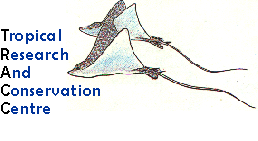|
|
|
|
Social behaviour of humphead wrasse
|
 |
|
|
|
| When carrying out behavioural observations it is
imperative that the observer can identify individuals. Many studies involve the
use of artificial markers or tags which involve catching, immobilising, and
other invasive techniques. The possibility of the artificial tag or marker then
altering the natural behaviour of the individual is also then contentious.
|
A FULLY MATURE MALE (MEASURING OVER 150 cm) EXHIBITING THE "YAWNING" BEHAVIOUR.
The larger fish were occasionally observed to angle themselves away from the reef wall and yawn in a definite head down posture in the presence of smaller humphead wrasse individuals. The "yawning" behaviour could be seen as a form of communication between conspecifics. |
Between fish there is little aggression except during spawning when large males charge at and chase away smaller males who sneak into the territory. Dominant males are frequently seen with scars and split lips from fighting over harems between the largest males.
A LARGE MALE WITH SCRATCHES AND A SPLIT UPPER LIP, WHICH RESULTED FROM FIGHTING WITH OTHER MALES DURING SPAWNING. |
|
Humphead wrasse go through 3 life stages, progressing from immature / juvenile fish (measuring up to about 40 cm) to breeding females (between 40 - 90 cm), and finally large males (more than 120 cm and weighing more than 22 kg).
Large green inter-sex individuals (about 90 - 120 cm) changing from female to male usually have a smaller or non-existent hump. |
|
||||||
LARGE BREEDING MALE (>120 cm). NOTE THE LARGE HUMP. |
|
||||||
| Accurate knowledge of territory size, courtship behaviour and social behaviour will be paramount for successful fish husbandry in the future enabling the rearing of farmed fish for the restaurant trade, thereby reducing the pressure upon natural populations. |
|HUMPHEAD WRASSE IN SABAH| |HUMPHEAD WRASSE AND THE LIVE FISH TRADE| |POPULATIONS AND SIZES| |NATURAL IDENTIFICATION|

![]()